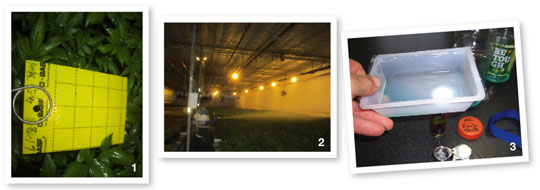10/29/2013
Cost-Effective Thrips Control
Roger McGaughey

I think it’s time to get on my nematode soapbox again. One of the pleasant benefits of writing these articles is the feedback that sometimes comes my way following each publication. After the last one, I received an email with the question, “Will nematodes work to control thrips in a few specific crops?” The reply was yes. Another grower friend also told me recently that he was totally fed up spraying chemicals and still had a serious thrips problem. “I’ve sprayed four different chemicals for the past four weeks and I’m fed up suiting up spraying nasties and getting nowhere. You have to help me set up a biological program.”
We talked about his past nematode use and quickly concluded that it was neither regular nor comprehensive enough. I’ve been using nematodes (
Steinernema feltiae) for four years and am convinced that regular applications are imperative for success. Biological control is all about prevention. Nematodes control different stages of the thrips life cycle and also fungus gnat larvae. A constant barrage of nematodes helps keep the population of these two pests under control. It may not be possible to totally eliminate both, but certainly they can be controlled to levels that will ensure minimal crop damage.
Weekly or more frequent applications all year long are important. There’s a wealth of knowledge on the Becker Underwood (now BASF) website where one can find ideal application temperature ranges and the correct climatic conditions to ensure success. Basically, between 50 to 80F (10 to 26C) and cloudy, dark or rainy conditions are appropriate. As nematodes attack thrips adults, larvae and pupae on plant foliage, it’s essential to keep the foliage moist for at least two hours after application. Pulling a shade curtain, if available, can help create the right environment. It’s very important to remember that as the ambient temperature increases so does the leaf temperature, so evaporation rates from the leaf surface will increase. Nematodes don’t work on dry leaf surfaces (Figure 1). Applications to the soil surface help control fungus gnat larvae and thrips pupae, so if nematodes are used from the crop outset, all surfaces—including floors/weed mats, etc.—will be targeted.
When I first started using nematodes I simply mixed 250 million in a 5-gal. bucket of water with 4 oz. of Capsil and 1 oz. of blue dye. Using a small pump for agitation and removing the filter from the suction hose of a Dosatron set at 1:100, I applied them through a hosepipe. By using a shutoff or my thumb over the hose outlet, I sprenched the nematode mixture. Now we use a sprayer with a large nozzle and a working pressure of about 250 psi. Do not exceed 300 psi (Figure 2).
Unlike chemicals, more is good and resistance will not happen as a result of over application. With nematodes, it’s possible and recommended to check the mixture throughout the spray process to verify viability (Figure 3). Wriggly/curly worms are good. Straight or needle-like worms are not. They could be dead or just cold if the temperature is too low. Once you’ve confirmed that the nematodes are active you can relax, knowing that pest control is working.
Now to the cost factor.
How many nematodes do you use and how much does this cost?
One packet of 250 million nematodes in 100 gals. water plus 8 oz. spreader sticker and some blue dye will spray 35,000 sq. ft. If this is done every week of the year, the cost is less than 10 cents/sq. ft./year. Cheap at the price. Start adding up the cost of all the chemicals that may not give adequate control and you might get a big surprise.
The other winner here is the customer, whether it’s another grower, as in our case, or ultimately the homeowner. They get crops with clean, unmarked foliage without pesticide residue. So a better end result for a greener, cleaner world.
Try it. Use nematodes and you’ll wish you had made the change years ago.
GT
Roger McGaughey, head grower at Pioneer Gardens in Deerfield, Massachusetts, was educated in Northern Ireland and England and has 40 years experience as a grower.